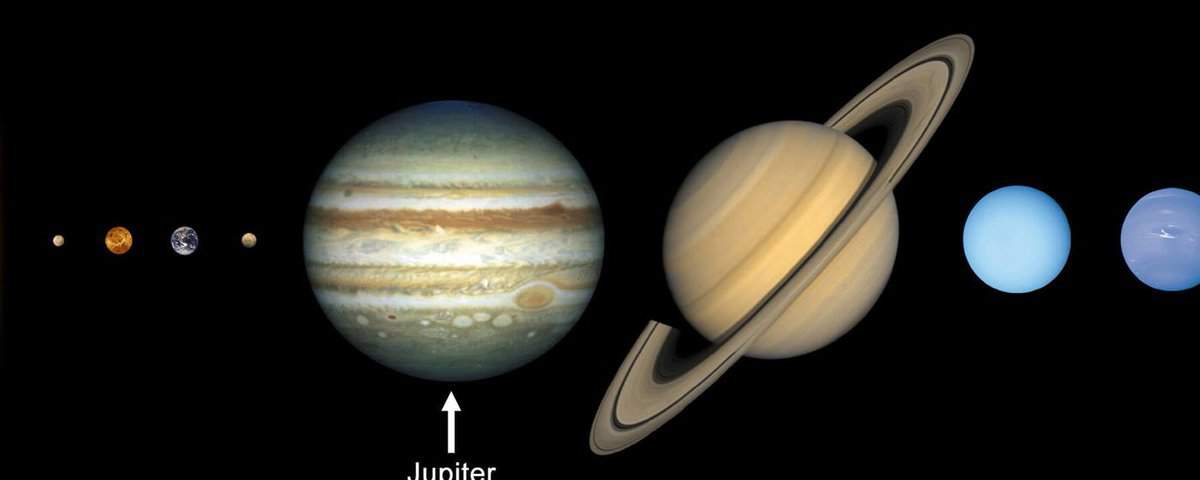Jupiter, the largest planet in the solar system, is located as the fifth planet from the sun. At present, there are a total of 79 known satellites revolving around Jupiter, with the possibility of more yet to be discovered. Jupiter’s orbit places it approximately 778 million kilometers away from the Sun.
Being classified as a gas giant, Jupiter lacks a solid surface. However, if it does possess a solid inner core, it is estimated to be similar in size to Earth. The composition of Jupiter’s atmosphere is primarily composed of hydrogen and helium gases.
The initial detailed observations of Jupiter were conducted by Galileo Galilei in the year 1610. Nonetheless, the existence of this planet has been recognized since ancient times.
In ancient Roman mythology, Jupiter (known as Zeus in Greek mythology) was regarded as the ruler of the sky and the supreme god among all other deities. Consequently, the largest planet in our solar system was christened after the king of the gods.
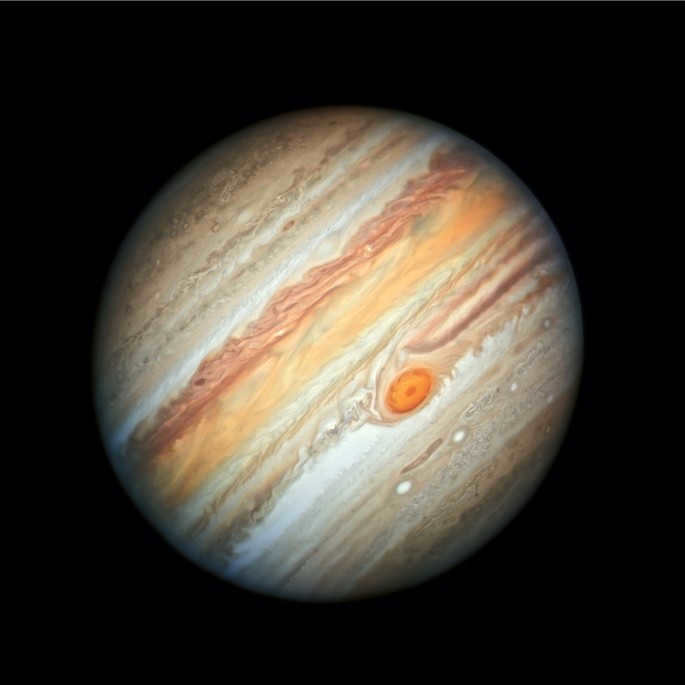
The massive storm known as the Great Red Spot, which can be observed in the photograph, is an enormous tempest that surpasses the size of our planet and has been raging for countless centuries. The bands and swirls visible in the image are actually chilly, gusty clouds composed of ammonia and water, suspended within an atmosphere primarily composed of hydrogen and helium.
A single day on Jupiter lasts roughly 10 hours, while a complete orbit around the Sun, constituting a year on Jupiter, spans the equivalent of 12 Earth years. Hence, this gas giant possesses a relatively short day and an exceptionally elongated year.
In 1979, astronomers made the remarkable revelation that Jupiter possesses a faint ring system, primarily consisting of fine particles of dust.
Distinctive Features
| Jupiter is known to have 79 satellites |
| The equatorial diameter of Jupiter is 142,984 kilometers. |
| Jupiter has a mass of 1.898E27 kg |
| Jupiter has a radius of 69,911 km |
| Above the clouds, the temperature on Jupiter is -145°C, but as you go deeper into its interior, the temperature rises to +9700°C, possibly even +Z5700°C. |
| On average, the distance from the Sun to Jupiter is 778.57 million km |
| The minimum distance from Earth to Jupiter is 588.5 million km, while the maximum distance is 968.6 million km. |
| A day on Jupiter lasts 9 hours and 56 minutes |
| A year on Jupiter is equivalent to 12 Earth years |
Jupiter’s Satellites
Currently, there are a total of 79 satellites orbiting Jupiter, which are also known as moons. Out of these, 53 have already been given names, while the remaining 26 are still awaiting official confirmation.
- Ganymede (the largest moon in the entire solar system and one of the four Galilean satellites)
- Io (the moon closest to Jupiter among the four Galilean satellites)
- Callisto (the second largest moon and one of the four Galilean satellites)
- Europa (the smallest among the four Galilean satellites)
- Dia (an irregular moon)
In addition to its moons, Jupiter also possesses a faint ring system primarily composed of dust particles.
What is the reason behind Jupiter having a large number of satellites?
Jupiter, being a gas giant, possesses such immense size that it is capable of attracting a greater number of satellites due to its powerful gravitational field. Consequently, Jupiter boasts numerous satellites as a result of its exceedingly strong gravitational field and magnetosphere.
An additional factor contributing to this phenomenon is Jupiter’s significant distance from the Sun. While gas giants like Jupiter are indeed massive, stars such as the Sun are even more enormous and possess stronger gravitational fields. If the Sun were to approach Jupiter closely, it could potentially take away the satellites belonging to this gas giant (with the strength of the Sun’s gravitational pull decreasing the further away one moves from it). Due to its substantial distance from the Sun, this colossal planet manages to avoid the possibility of having its satellites taken away.
Jupiter’s Atmosphere, Surface, and Structure
The Composition of Jupiter’s Atmosphere
Jupiter, the gas giant, is predominantly comprised of:
- Hydrogen, which makes up about 90% of the atmosphere
- Helium, which accounts for approximately 10% of the atmosphere
- Small amounts of other gases such as ammonia, sulfur, methane, and water vapor
Ammonia is the primary component of the clouds visible in photographs of Jupiter, but there are also water clouds present beneath the ammonia clouds.
Jupiter’s vibrant streaks and swirling patterns are created by cold, windy clouds composed of ammonia and water. These clouds float within an atmosphere of hydrogen and helium. While the intensity and width of the streaks have changed over the course of more than 200 years, the winds responsible for these features have remained constant.
Surface
Jupiter does not possess a solid surface suitable for landing. Additionally, the planet’s surface is characterized by an incredibly strong gravitational force. In fact, Jupiter’s gravity is 2.5 times greater than that of Earth. To put it into perspective, if your weight on Earth is 100 kg, on Jupiter it would be equivalent to 250 kg. It is important to note that due to the absence of a solid surface, any attempt to stand on Jupiter would result in being engulfed by the planet itself.
Composition
The composition of Jupiter’s atmosphere primarily consists of hydrogen and helium. As one descends deeper into the atmosphere, the pressure and temperature rise, causing the hydrogen gas to transition into a liquid state. This unique feature gives Jupiter the distinction of having the largest ocean in the entire solar system, albeit not made of water, but rather composed of hydrogen.
Approximately halfway towards the planet’s core, the pressure becomes incredibly intense, resulting in the liquid becoming electrically conductive, resembling the properties of metal. Additionally, scientists theorize that the planet’s rapid rotation generates electrical currents in this region, contributing to the formation of its immensely powerful magnetic field.
Despite extensive research, the nature of Jupiter’s core remains a mystery. Scientists speculate that it could either be solid or liquid, but what is known is that the temperature at its center can reach an astonishing +50,000°C.
Jupiter, the gas giant, is the solar system’s fifth-largest planet, positioned between Mars and Saturn. It is only surpassed in size by the Sun. With an equatorial radius 11 times that of Earth, Jupiter is a massive planet. Its mass is over twice that of all the other planets in the solar system combined, making it 318 times more massive than Earth. Jupiter takes nearly 12 years to complete one orbit around the Sun, traveling at a speed of approximately 13 km/sec. Interestingly, the planet spins much faster than Earth, with a day lasting around 10 hours.
Jupiter is undeniably the gem of our celestial neighborhood. During nights devoid of light, the most radiant pearl emerges in the eastern sky, bestowing a magical allure upon the celestial canopy. This celestial body is second in luminosity only to Venus. Since ancient times, the luminous gaze of this planet has captivated and astounded individuals. It is not by chance that it was christened after the revered Roman deity of thunder and lightning.
The composition of Jupiter’s atmosphere is significantly distinct from that of Earth. It primarily consists of hydrogen (approximately 89%) and helium (approximately 11%). However, there are also minor components such as methane, ammonia, acetylene, and water vapor. When observing the planet through a telescope, one can observe an amalgamation of parallel bands of varying hues, including red, white, yellow, and blue. These bands are formed by clouds of diverse colors in the upper layers of the atmosphere, creating dark belts and light zones.
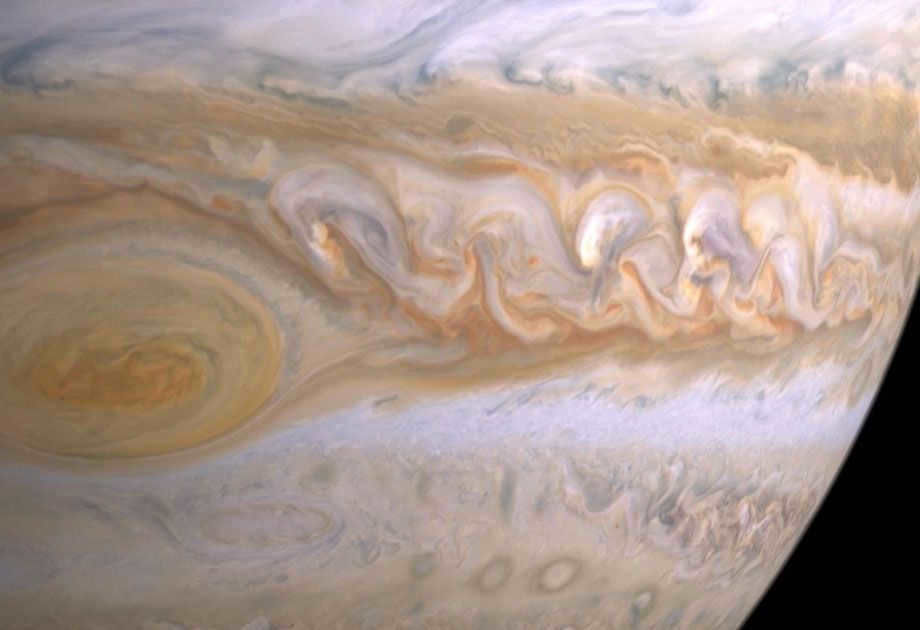
Spots on Jupiter
One notable characteristic of Jupiter is the presence of spots. These spots are actually massive whirlpools that can persist for extended periods of time, ranging from weeks to months and even years. One such spot measures about 15,000 kilometers in diameter. Among these spots, the most renowned is the Great Red Spot, which was initially observed and recorded by the French astronomer Cassini in 1664. Remarkably, despite the passing centuries, the Great Red Spot has remained relatively stationary and has maintained its shape and size.
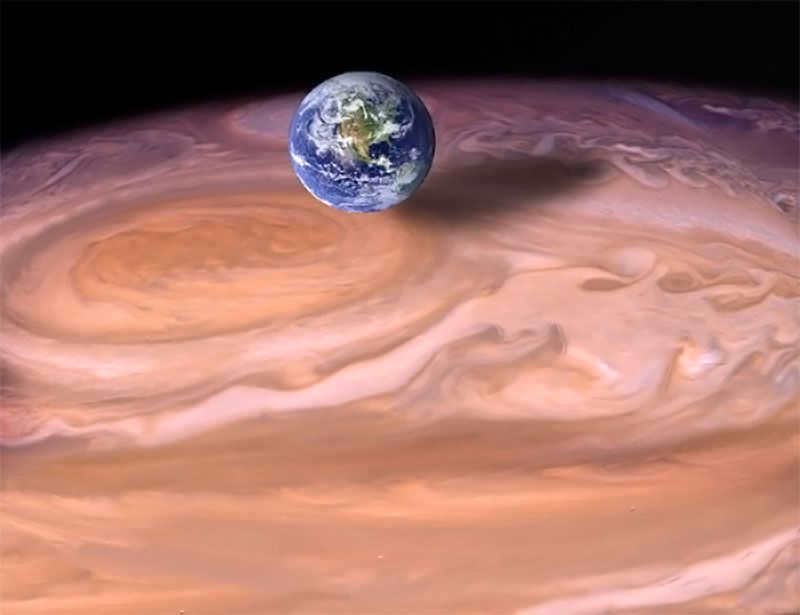
The Great Red Spot is truly remarkable with its dimensions of 12,000 kilometers by 48,000 kilometers. Many theories suggest that it could be a colossal vortex or an enormous cloud. Another hypothesis proposes that it formed due to a planetary collision with a massive object. It is believed that this object caused the ejection of planetary material, which then scattered into space.
Rings
Similar to Saturn and Uranus, Jupiter also possesses rings, albeit less prominent in comparison. Primarily composed of gas and dust, the ring system of Jupiter consists of four distinct components. These include a dense torus comprised of minuscule particles, a remarkably thin “Main Ring” that emanates a bright glow, as well as two broader rings known as “spider rings”. When observed within the visible spectrum, the rings exhibit a reddish hue, with the exception of the first ring, which appears blue.
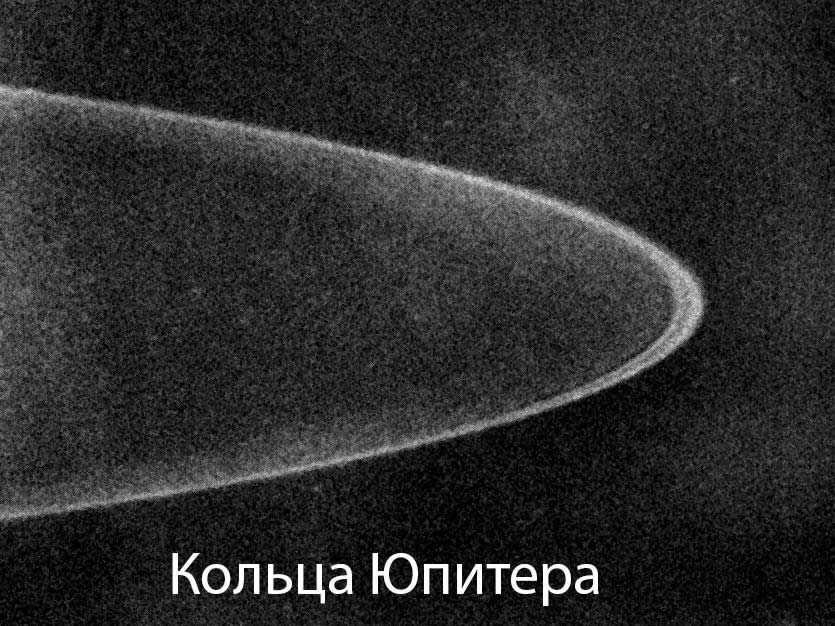
Composition of Jupiter
Due to being a gas giant, Jupiter lacks a traditional surface. However, scientists believe that at the center of this massive planet lies an extremely dense core. This core is subject to immense pressure, ranging from 30 to 100 million atmospheres. Additionally, the core’s temperature is an astonishing 30,000 degrees Celsius.
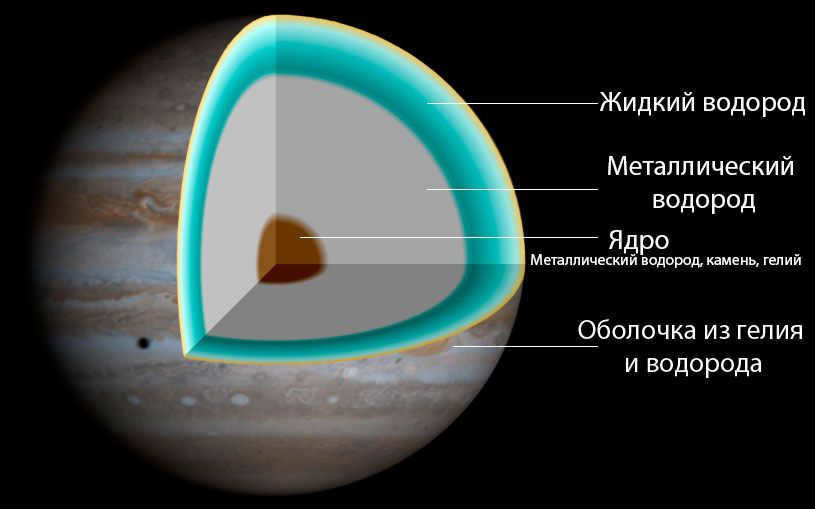
Jupiter possesses a unique internal structure, with a fascinating ocean of liquid hydrogen existing 100 kilometers beneath its surface. Moreover, at depths below 17,000 kilometers, the hydrogen is subjected to immense pressure, causing it to exhibit metallic properties. This metallic hydrogen is capable of conducting electricity, thereby generating a magnetic field that envelops the entire planet. The dimensions of this magnetic field are truly astounding, spanning a distance of 650 million kilometers and even slightly overlapping with Saturn’s orbit. The shape of the field is elongated, with it being 40 times smaller when directed towards the Sun.
Jupiter’s Satellites
As of 2009, a total of 63 satellites have been identified orbiting Jupiter. The most well-known are the Galilean satellites, which were first discovered in 1610 by a scientist named Galileo Galilei. These satellites include Ganymede, Callisto, Europa, and Io. Ganymede, the largest of Jupiter’s satellites, is even larger than the planet Mercury. Callisto, nearly the same size as Ganymede, has a dark surface covered in craters. Europa, on the other hand, is surrounded by a thick ice shell that is about 100 kilometers thick. This ice shell gives Europa a bright reflective quality, similar to that of the planet Venus. Finally, Io is the most visually striking satellite, with its vibrant shades of yellow, black, and red. This unique coloring is a result of its active volcanic activity, which causes sulfur fountains to erupt up to 200 kilometers above its surface.
Fascinating information about the planet
- NASA’s Voyager probe once detected peculiar sounds emitted by the planet. These sounds bore a striking resemblance to speech and were referred to as electromagnetic voices. So, is the planet actually communicating? Who would be able to interpret this conversation?
- Another peculiar characteristic is the behavior of shadows. Normally, it is cooler in the shadows compared to outside. However, on Jupiter, the opposite is true. The temperature is higher in the shade than in the open. There is only one explanation for this phenomenon. It appears that this planet, unlike others, reflects more heat than it receives from the sun.
Comet trap
Without Jupiter, it is unlikely that we would be able to access this information at the present moment. Over the course of billions of years, Jupiter’s immense gravitational force has been responsible for capturing or deflecting comets and asteroids that were hurtling towards the Sun. The most recent incident took place in 1994, when this celestial guardian shielded us from yet another potential threat. Jupiter’s gravitational pull shattered Comet Shoemaker-Levy like a powerful hammer striking a fragile pebble.
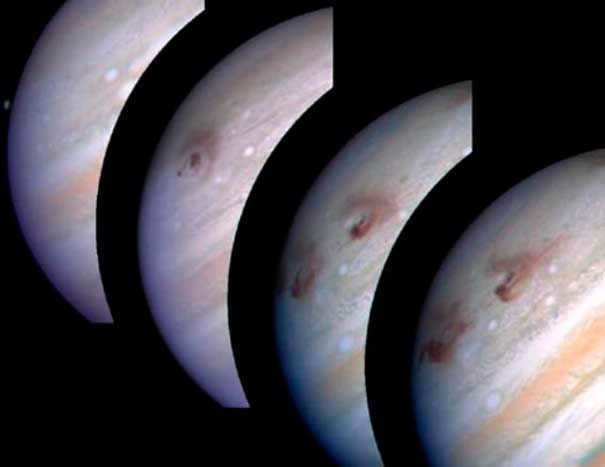

The impact of the largest fragments resulted in explosions that surpassed the destructive force of a 100-megaton hydrogen bomb by a magnitude of 10,000. However, due to the events occurring on the nocturnal hemisphere of the planet, visual observation was not feasible.
Exploring the Wonders of Jupiter
With a couple of years of free time on our hands, we embarked on an extraordinary journey to Jupiter. Naturally, the best way to pass the time during the long flight was to indulge in the realm of dreams, as gazing at the uniform expanse of space for two to three years would become rather tedious.
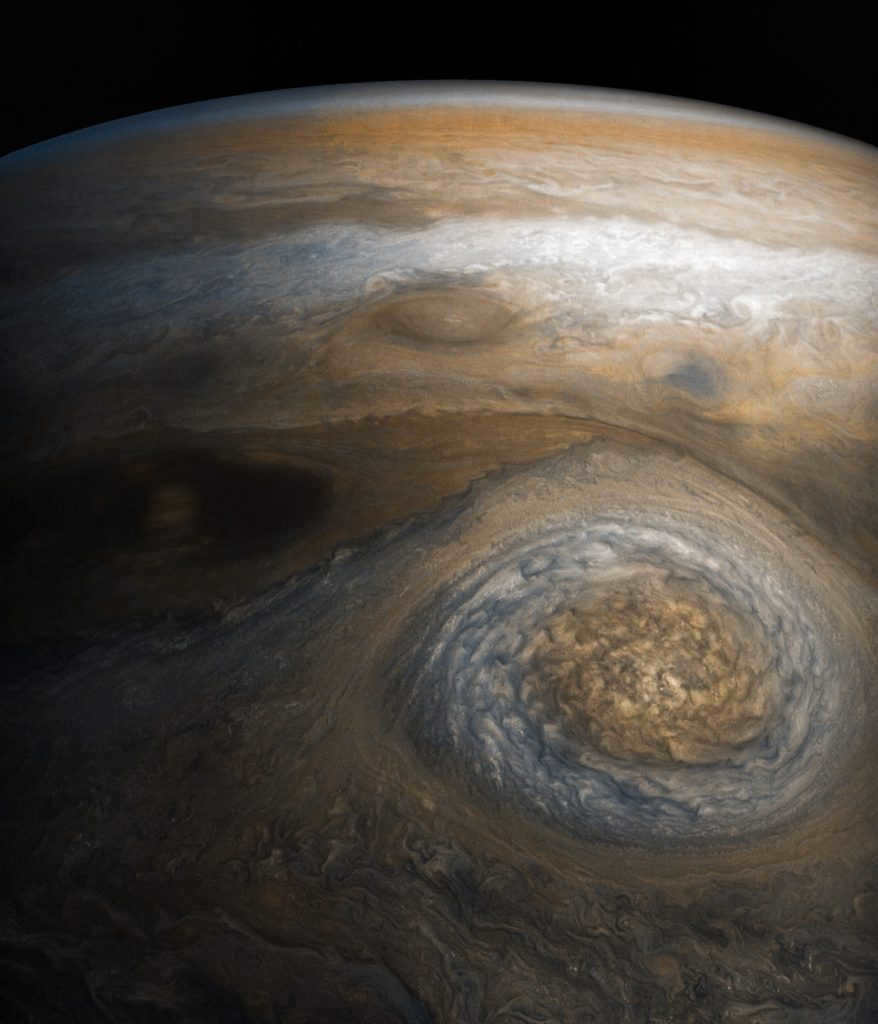
At this moment, we have successfully completed a journey of 778 million kilometers, and our spacecraft has now entered the massive planet’s orbit. It is fortunate that the spacecraft is equipped with powerful heating systems, as the surface of Jupiter is incredibly cold. However, for those who enjoy cryogenic baths, the temperature of -130 ° C will be quite enjoyable, and the atmospheric pressure is similar to that of Earth. The key is to not prolong your stay or venture deeper into the atmosphere.
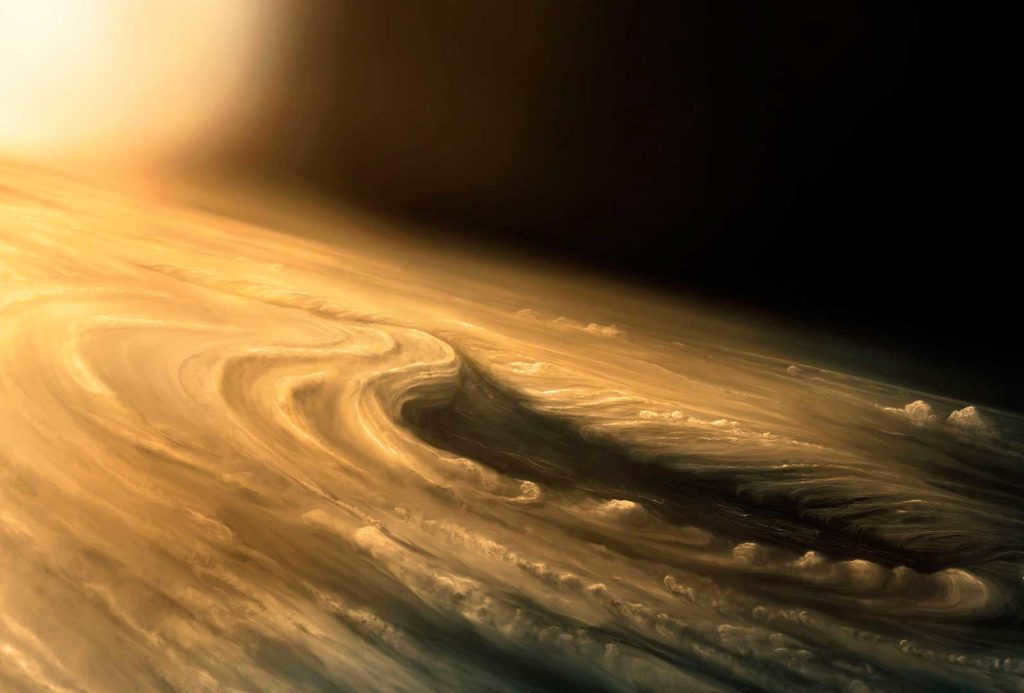
Once we have traveled 130 kilometers, the temperature dramatically increases to +150 ° C, and it is the perfect opportunity to prepare some delicious kebabs. However, the pressure of 24 atmospheres would transform it into a pâté. Nevertheless, we will not venture into the depths of the planet’s hydrogen, as it is highly unlikely that we will come across any signs of life. Instead, let’s explore the vastness of the space colossus.
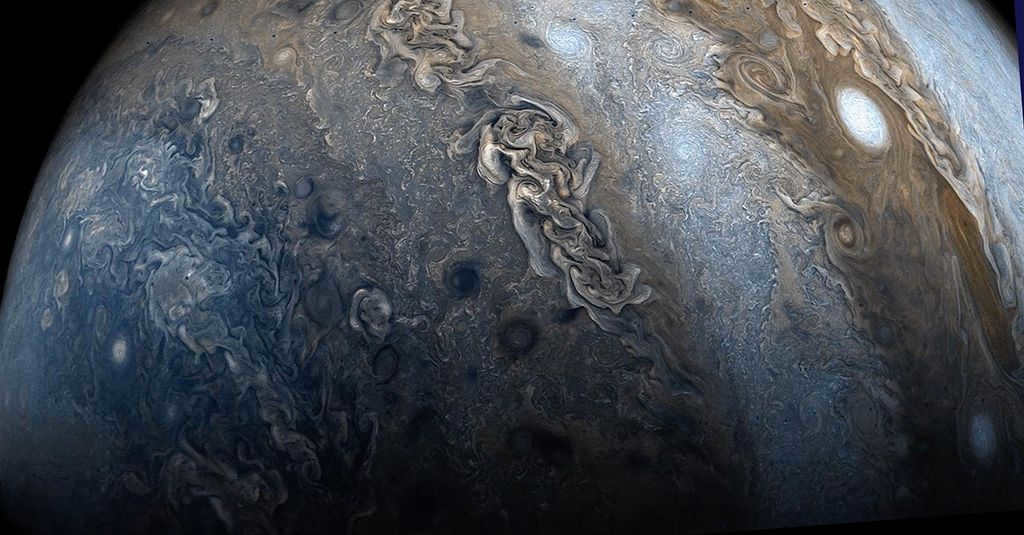
As we traverse the planet at an average speed of 600 km/hour, we are greeted by a breathtaking spectacle. The polar lights on Jupiter are far more intense than those found on Earth, but their true beauty can only be fully appreciated in the ultraviolet range.
However, the lightning storms on Jupiter are a sight to behold. They are thousands of times more powerful than the lightning we are familiar with on our own planet, resembling fiery rivers. These rivers cut through the planet’s enduring cloud belts, which remain unchanged for years, racing across the planet at a speed of 500 kilometers per hour.
The uniqueness of the planet Jupiter is evident in its status as the largest planet in the solar system. This gas giant is incredibly massive, measuring over 2.5 times the size of all the other planets and satellites in its system. A simple inquiry about Jupiter is its position relative to the Sun. As the fifth planet from the central star, it is one of the four outermost planets. Jupiter is also accompanied by numerous satellites and rings of varying sizes. Scientists studying this colossal planet and its satellites are constantly pondering a multitude of queries.
The pioneers and adventurers who discovered Jupiter
Jupiter, a celestial body that can be observed with the naked eye, has a rich history of discovery. Due to its visibility, it is impossible to determine the exact person who first noticed its movement across the night sky. Throughout history, various cultures have bestowed different names upon Jupiter. The Sumerians and Akkadians referred to it as the captivating “White Star”. In ancient China, astronomers meticulously documented its 12-year orbital period and bestowed upon it the prestigious title of “Star of the Year”. The ancient Greeks associated Jupiter with their supreme god, Zeus, symbolizing its significance. The Romans, recognizing its importance, dedicated it to one of their most revered deities – Jupiter.
Comparing the sizes of Jupiter and Earth
The composition and appearance of the planet
When it comes to studying the makeup of Jupiter, scientists often draw comparisons to the Sun. It is believed that Jupiter is composed of approximately 89-90% hydrogen, 9.99% helium, and trace amounts of other compounds. Deep within its atmospheric layers, there is a suspected helium-hydrogen ocean. Below that, there is thought to be a solid layer of metallic hydrogen and a relatively small rocky core, especially considering Jupiter’s massive size. The planet is surrounded by clouds of ammonia ice crystals, with storms of hydrogen sulfide, methane, and water constantly churning and swirling within the mingling gases.
The appearance of Jupiter from the side is determined by the mixing and weaving of multicolored stripes of storms composed of ammonia, methane, hydrogen sulfide, water, phosphorus, and carbon compounds. The planet is observed as a slightly flattened striped ball, adorned with hues of red, yellow-brown, and white. Dark and light patches of clouds and reddish storm swirls add to its visual appeal. Jupiter’s magnetic field, combined with the release of lava and ash particles from its moon Io’s volcanoes, creates a mesmerizing display of northern lights over the planet’s poles. As these dust particles are captured by the magnetosphere and propelled at incredible speeds, they produce a breathtaking spectacle of light emission.
Weather and the planetary rhythms
When it comes to the weather on Jupiter, one word sums it up perfectly – stormy. The winds on this planet can reach an astonishing speed of 360 kilometers per hour in the atmosphere, and even 420 km/h on the outskirts of the Great Red Spot. The length of a day on Jupiter is determined by its rapid rotation, which is the fastest among all the gas giants in our solar system. In fact, it only takes 9 hours, 55 minutes, and 30 seconds for Jupiter to complete a full rotation. This remarkable speed can be attributed to the planet’s abundance of storms and hurricanes.
The Big Red Spot, a massive storm that has been swirling through the planet’s atmosphere for 300-400 years, is longer-lasting than any other phenomenon. Although its diameter is gradually decreasing, it remains significantly larger than the Earth. On the other hand, the Small Red Spot is expanding in size. Meanwhile, the Great Spot is fading in color, while the Small Spot is becoming brighter. In addition to these features, numerous small storms resembling bright spots continuously form within the cloudy expanse. These storms can last anywhere from a few hours to several decades.
To estimate the length of a day on Jupiter, scientists have traditionally relied on tracking the movement of large storm patterns. However, this approach has proven to be somewhat imprecise due to the rapid movement of storm spots in the planet’s atmosphere. As a result, researchers have turned to monitoring periodic changes in Jupiter’s magnetosphere for a more accurate measurement. Their calculations have revealed that a single year on Jupiter is nearly equivalent to 12 Earth years.
The arrangement of matter within Jupiter consists of a combination of hydrogen and helium, forming an outer layer, which is then followed by a layer of hydrogen in both liquid and metallic states. It is speculated that there may exist a solid core within the planet.
What phenomena occur on the surface of Jupiter?
The query “What is the outer layer of Jupiter?” is not as straightforward as it initially appears. Gas giants exhibit a lack of distinct boundaries between their atmosphere and other regions of the planet. The demarcation line for the outer layer is a pressure of 1 bar, similar to that found on Earth. Following this criterion, the outer layer is situated in the upper part of the atmosphere. Determining the actual topography of Jupiter is also exceedingly challenging. Some scientists propose that this gas giant lacks a solid core altogether. According to their hypotheses, it is composed of molten rocks, hydrogen, and bears a resemblance to the texture of an intensely hot, dense soup.
Satellites and Rings
In the Middle Ages, scientists confirmed the existence of satellites orbiting Jupiter. In 1610, Galileo Galilei observed the four largest satellites through a telescope, which are now known as the Galilean satellites. Further research in the 70s revealed the existence of an additional 13 celestial bodies orbiting Jupiter. Today, different sources provide slightly different numbers, with 63 well-studied satellites being commonly recognized. However, the total number varies among scientists, ranging from 67 to over 100. This discrepancy arises from the possibility that not all of Jupiter’s “moons” have been discovered yet. The thin rings surrounding the planet are less prominent compared to Saturn’s famous rings.
Typically, when enumerating the satellites of Jupiter, the names are arranged in accordance with their proximity to the planet. The initial four, which are the innermost four, revolve within rings primarily composed of particulate matter. A dense dust halo is situated in close proximity to the planet’s surface. The orbits of the satellites Adrastea, Amalthea, and Thebes demarcate the other, more delicate rings. Within the first ring, Metida orbits, having the closest trajectory to the planet. Following this are the prominent main ring and two spider rings. It is believed that these rings are formed as a result of dust generated by the satellites’ high-velocity collisions with meteoroids and particles emitted from volcanic activity on them.
Moons of Jupiter
The nearest major moon of Jupiter to the planet that exhibits volcanic activity is Io, which was discovered by Galileo in 1610. It boasts over 400 active volcanoes, spewing lava up to a height of 400 kilometers. Io is the swiftest among the four largest moons of Jupiter. Its close proximity to the massive parent planet results in a relatively powerful gravitational connection. The neighboring moons also exert significant gravitational influence, which impacts the volcanic activity of this celestial object. The yellowish hue of this moon is attributed to the presence of sulfur compounds in the ash and lava.
Europa, which is slightly smaller than the Moon orbiting the Earth, is composed of silicate rocks. Scientists are intrigued by the smooth ice crust covering the moon, as it suggests the presence of a hidden watery ocean beneath the icy surface. The satellite also boasts a rarefied, oxygen-rich atmosphere, further fueling speculation about the potential for life.
Ganymede, the largest of Jupiter’s moons, possesses its own magnetosphere. Its complex tectonic topography is believed to be the result of impact craters and possible tectonic activity on the moon.
Callisto, another of Jupiter’s moons, is just slightly smaller than Ganymede. Its orbital period coincides with its rotation around its axis, causing it to always face Jupiter on the same side.
Compared to the planet’s size, the rest of the satellites are relatively small. Their dimensions vary from 2 to 4 kilometers. Ongoing research is being conducted on each of these satellites, as well as the colossal gas planet. Scientists are constantly uncovering new mysteries and will undoubtedly continue to delve into the unexplored depths of this gas giant.
Other news:
Remember to share. Takeaway.
A closer look at the planets in our solar system. Jupiter. A favorite for stargazers
A closer look at the planets in our solar system. Jupiter
Jupiter, the largest planet in our solar system, is about 11 times the size of Earth. Its vibrant clouds and gas formations make it a truly captivating planet to observe.
Jupiter’s atmosphere is composed of 85% hydrogen and 14% helium. Despite being classified as a gas giant, deep beneath its surface lies a layer of highly pressurized hydrogen, giving it some metallic properties.
The reddish bands on Jupiter are known as “belts,” while the lighter bands are referred to as “zones.” These bands are actually clouds in the upper atmosphere.
Aside from hydrogen and helium, other substances present in Jupiter’s atmosphere include methane, toxic ammonia, water vapor, and acetylene. Thunderbolts can be seen in the outer layers of the atmosphere. As one goes higher into the atmosphere, the temperature drops to a chilling -160 °C before gradually increasing with depth. At a depth of 60 km below the upper boundary of the atmosphere, the temperature rises to 0°C, and it continues to climb, eventually surpassing the 100 °C mark.
At a depth of 100 km, hydrogen transitions from a gas to a liquid state. As one goes deeper, about 17 thousand kilometers down, hydrogen takes on the characteristics of a metal and becomes electrically conductive. This is why Jupiter has a magnetic field. Unfortunately, it is impossible to replicate metallic hydrogen in a laboratory setting.
Interestingly, Jupiter actually generates more heat energy than it receives from the Sun. The planet has three distinct sources of heat: residual heat from its formation, energy released through its gradual contraction, and energy from radioactive decay.
Jupiter’s magnetic field extends 50 times the diameter of the planet in every direction. The radio emissions emitted by Jupiter are the most intense ever recorded in our solar system.
Jupiter rotates at an incredibly rapid pace, completing one full rotation in just 10 hours. Due to this high speed, the appearance of the planet’s clouds can change within a matter of days.
One of the most fascinating features of Jupiter is the Great Red Spot, which is larger than the Earth itself. This spot was first observed over 300 years ago and remains a captivating sight.
Jupiter possesses a minimum of 63 satellites. Among them, Ganymede, which is larger than Mercury, stands out. Callisto, Europa, and Io also revolve around the planet. The remaining satellites that lie below Io’s orbit are considered remnants of satellites that no longer exist, while others are merely asteroids that have entered Jupiter’s gravitational field.
Aside from its satellites, Jupiter also boasts three faint rings composed of fine dust.
Jupiter has been captured in photographs by the Soviet Pioneer-10 and Pioneer-11 spacecraft, as well as two Voyager spacecraft. The most recent spacecraft, named “Galileo,” was launched in October 1989. The Hubble Space Telescope has also captured stunning images of Jupiter, rivaling those taken by the Voyager spacecraft.
Mass: 318 times the mass of Earth, which amounts to approximately 1.9 ? 1027 kg.
Equatorial diameter: 11.2 times the diameter of Earth, equivalent to 143,760 km.
Revolutionary period around its axis: 9.93 hours.
Mean distance from the Sun: 778 million kilometers.
Orbital period (year): 11.86 Earth years.
Jupiter is the largest planet, composed mostly of gas,
A wreath encircles this image of a palace.
Come on Earth-RosCosmos, Come on Earth-NASA,
Together we will uncover the treasures of this courtyard!
What is the fifth planet from the sun?
- Automobiles and motorcycles
- Motor racing
- Auto insurance
- Cars
- Service, maintenance, tuning
- Service, maintenance and repair
- Choosing a car, motorcycle
- Traffic Police, Training, Licenses
- Registration of auto-motorcycle transactions
- Other topics related to automobiles
- Arts and Entertainment
- Concerts, Exhibitions, Plays
- Cinema, Theater
- Painting, Graphics
- Other arts
- News and Society
- Social life and Showbiz
- Politics
- Society
- Society, Politics, Media
- Potted plants
- Leisure, Entertainment
- Non-computer games
- Black magic
- Occultism, Secret knowledge
- Divination
- Interpretation of dreams
- Astrology
- Other prophecies
- Other forms of entertainment
- Video editing
- Photo editing and printing
- Other photo and video services
- Photography, Videography
- Interests
- Jokes
- Military service
- Archives
- Clubs, Nightclubs
- Real Estate, Mortgages
- Other unknown categories
- Religion, Belief
- Tips, Ideas
- Gift Suggestions
- Goods and services
- Other industrial products
- Other services
- Unclassified
- Business
- Finance
- Well-being
- Pregnancy, Labor
- Illnesses, Medications
- Doctors, Clinics, Insurance
- Children’s Health
- Healthy lifestyle
- Beauty and Health
- First courses
- Second dishes
- Cooking in …
- Cooking for children
- Desserts, Sweets, Pastries
- Appetizers and Salads
- Canning
- Quick
- Beverages
- Grocery shopping and selection
- Other culinary
- Feast, Celebration
- Friendship
- Acquaintances
- Love
- Relationship
- Other relationships
- Other social topics
- Breakups
- Weddings, Getting married, Marriage
- Computers
- Web Design
- Hardware
- Internet
- Advertising
- Appetizers and Salads
- Other projects
- Computers and Communication
- Beeline – Telecommunications Company
- Mobile communication services
- Mobile devices and gadgets
- Online shopping and e-commerce
- Software development and programming
- Java programming language
- Cooking in the kitchen
- Cooking tips and recipes for kids
- Desserts, Sweets, and Baking recipes
- Appetizers and Salads preparation
- Canning and preserving food
- Homework tips and advice
- Schools and educational institutions
- Architecture and Sculpture
- Business and finance topics
- Macroeconomics principles
- Accounting, Auditing, and Taxes
- Universities and Colleges
- Education opportunities abroad
- Humanities subjects
- Natural Sciences and scientific research
- Literature analysis and reviews
- Publishing and writing industry
- Psychology studies and research
- Philosophy, unknown concepts
- Philosophy theories and ideas
- Linguistics and language studies
- Additional education options
- Self-improvement techniques
- Music appreciation and genres
- Science and Technology
- Technology
- Choosing and purchasing equipment
- Techniques
- Other forms of education
- Science, Technology, and Languages
- Administrative Law
- Criminal Law
- Civil Law
- Financial Law
- Housing Law
- Constitutional Law
- Social Security Law
- Labor Law
- Other legal matters
- Independent vacations
- Travel
- Around the World
- Residency and Real Estate
- Other information about cities and countries
- Wildlife
- Maps, Transportation, and GPS
- Climate, Weather, and Time Zones
- Restaurants, Cafes, and Bars
- Vacationing abroad
- Hunting and Fishing
- Documents
- Other tourist-related topics
- Work Environment
- Resume writing
- Staffing agencies
- Alternate business sectors
- Personnel Management, HR
- Flexible, temporary employment
- Production companies
- Personal growth
- Other employment concerns
- Employment, Profession
- Transitioning and securing employment
What is the fifth planet from the sun?
Is it easier to inquire here rather than inputting it into a search engine?
There exists a fascinating myth surrounding the shattered fifth planet – Phaeton, which is now known as the asteroid belt. Presently, it is more likely that this belt is a collection of scattered debris rather than the remains of a once whole planet, although the possibility of Phaethon’s existence cannot be completely ruled out.
Jupiter is a colossal planet, positioned fifth from the Sun and holding the title of the most extensive celestial body in the entire Solar System. Its equatorial diameter measures a whopping 142,800 kilometers. Jupiter possesses a staggering amount of mass, accounting for a staggering two-thirds of the total mass of all other planets in our solar system. This gargantuan planet dwarfs Earth in size, as it is a staggering 318 times more massive and boasts a visible surface area that is a staggering 120 times larger than our own planet. It comes as no surprise that Jupiter’s luminosity in the night sky is only surpassed by Venus and Mars during the latter’s oppositions.
Describing the atmosphere and ocean of Jupiter is a challenging task due to the fact that the entire planet is a massive gas sphere, primarily composed of hydrogen and helium. A small portion of Jupiter’s overall mass consists of various other gases and substances, some of which contribute to its distinctive orange hue. At a depth of approximately 25,000 kilometers from the outer layer of Jupiter, the pressure skyrockets to 3 million atmospheres, accompanied by a scorching temperature of 11,000,000 degrees Celsius. Scientists have determined that under such extreme conditions, hydrogen would adopt the properties of molten metal. Furthermore, calculations suggest the presence of a dense core composed of actual molten metals at the very center of the planet, with temperatures exceeding 30,000 degrees Celsius. The surface of Jupiter has a low gas density, while the interior boasts an incredibly high density, resulting in an average density for the planet that is comparable to that of water.
Jupiter, which is located 778 million kilometers (5.2 a. e.) away from the Sun on average, accomplishes a full orbit around the Sun in 11.86 Earth years. The energy received by Jupiter from the Sun is equivalent to half of the energy emitted by its heated interior. The surface temperature of its gaseous ocean does not surpass -140 °C.
Despite its immense magnitude, Jupiter has a rapid rotation around its own axis, completing a full revolution in a mere 9 hours and 55 minutes. Simultaneously, the planet’s gaseous atmosphere is home to incredibly powerful vortices and cyclones, hurtling at speeds of approximately 100 meters per second. Some of these atmospheric phenomena reach staggering sizes, spanning hundreds and even thousands of kilometers. Scientists propose that one such colossal, enduring vortex is the enigmatic Red Spot, a feature that has been observed on Jupiter’s surface for three centuries. Remarkably, the Red Spot completes a full revolution every century.
Jupiter gracefully traverses the night sky at a leisurely pace. Recognizing this characteristic, the ancient Greeks dedicated the planet to the supreme god Zeus, who corresponds to Jupiter in Roman mythology.
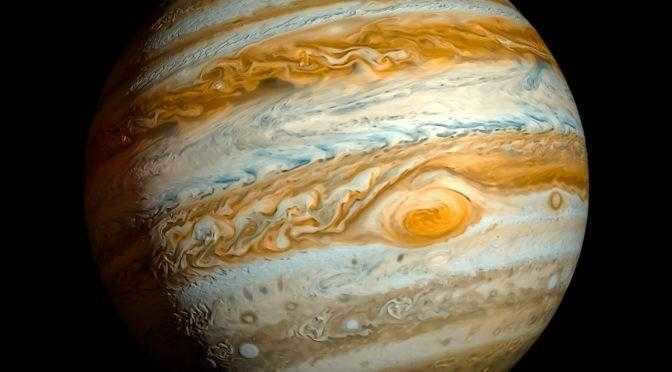
Jupiter is positioned as the fifth planet in our solar system, at a distance of approximately 5.2 astronomical units (a.u.) or roughly 770 million kilometers away from the Sun. This massive celestial body belongs to the gas giant category.
In terms of size, Jupiter surpasses Earth by a staggering factor of about 318 times. Its atmosphere primarily consists of hydrogen, which constitutes around 80 percent, along with traces of ammonia and various other gases. With an even greater mass, around 40-50 times more than its current size, Jupiter could potentially transform into a second star within our solar system. The immense compression of hydrogen within its core at this magnitude would trigger a spontaneous thermonuclear reaction.
Spectral analysis studies of Jupiter have revealed the absence of oxygen and water on the planet, ruling out the possibility of simple life. However, there are theories suggesting that a small amount of ice may exist in Jupiter’s atmosphere. The planet’s internal structure remains largely unknown, sparking extensive scientific debates. Valuable information about Jupiter has been transmitted by space interplanetary stations, allowing for the construction of a seemingly reliable model of its internal composition.
The structure of Jupiter’s interior
From a geometrical perspective, Jupiter takes the shape of a sphere with noticeable compression around its poles. The planet possesses a formidable magnetic field that extends across extensive distances. Jupiter’s atmosphere resembles a layered cake, with each layer exhibiting distinct characteristics. Scientists hypothesize that Jupiter harbors a solid core, likely denser and larger than Earth. Nevertheless, the existence of this core remains a theory that has yet to be substantiated.
The Composition and Conditions of Jupiter’s Atmosphere
Jupiter’s atmosphere is composed primarily of hydrogen and helium gases, along with other trace elements. It extends to a distance of up to 20,000 kilometers from the planet’s surface. Below this upper layer, there is a region that spans up to 60,000 kilometers and experiences increasing pressure, causing the gaseous mixture to transition into a liquid state. In this area, temperatures can rise to a scorching 20,000 degrees Celsius.
Deeper into Jupiter’s atmosphere, there is another layer that stretches to a depth of 65,000 kilometers. Here, the hydrogen gas begins to undergo a transformation into a metallic state. The temperatures in this layer can soar up to a staggering 200,000 degrees Celsius, while the pressures reach nearly 5 million atmospheres.
The planet is orbited by a multitude of natural satellites. These four prominent ones were first observed by the renowned scientist and astronomer Galileo Galilei. This groundbreaking discovery took place in December 1609 using the inaugural telescope in the world. The satellites that Galileo Galilei identified are named after figures from Greek mythology: Io, Callisto, Europa, and Ganymede. Presently, these celestial bodies are the subject of extensive research by scientists worldwide, as they hold potential for harboring life.
Fascinating Facts about Jupiter
Jupiter completes a full rotation on its axis in approximately 10 hours, despite its immense size. Unlike Earth, Jupiter does not experience seasons due to the alignment of its equator with the plane of the ecliptic.
One of the most intriguing features of Jupiter is its iconic Big Red Spot, which can be seen in every photograph of the planet. Scientists believe that the spot is actually a massive hurricane that has been raging in Jupiter’s atmosphere for over 400 years. It spins around its center at a speed of 300 kilometers per hour.
Jupiter emits X-rays and pulses every 40 minutes, although the exact cause of this phenomenon remains a mystery.
The 15 closest satellites to Jupiter, listed in descending order from the planet, are: Metida.
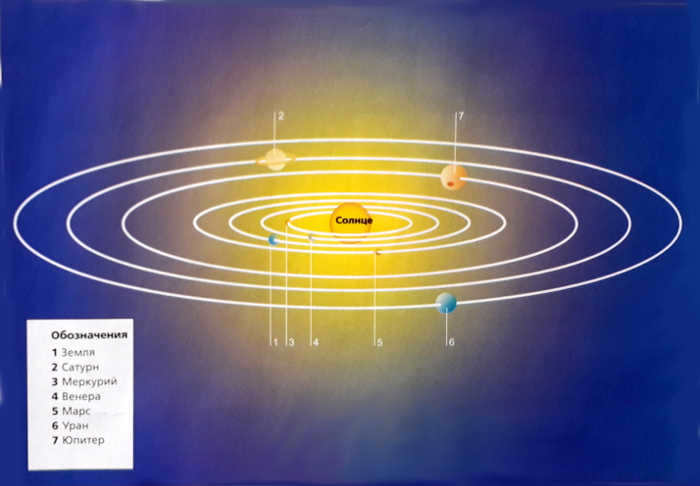
The data on Jupiter is outlined in this article, including its description, characteristics, information about its orbit, rotation, and atmosphere.
Jupiter’s maximum distance from the Sun (aphelion) is 816 million kilometers (5.45 a.u.).
Jupiter’s minimum distance from the Sun (perihelion) is 741 million kilometers (4.95 a.u.).
Jupiter’s diameter at the equator is 142,600 km.
Jupiter’s average upper atmosphere temperature is -149°C.
Jupiter’s circulation period around the Sun is 11.86 Earth years (11 years 315 days).
Jupiter’s period of revolution around its axis is 9 hours 50 minutes.
Jupiter has a total of 67 moons (satellites).
This celestial body derives its name from the deity of highest authority in the ancient Roman religion, who held dominion not just over mortals but also over other divine beings. Veiled in vibrant clouds, Jupiter stands as the fifth celestial body in the solar system – and the most massive of them all. With an equatorial diameter surpassing 142,500 kilometers, it is 11.1 times the size of our home planet, and its volume is a staggering 1,279.4 times that of Earth. The mass of Jupiter is equally colossal: it accounts for approximately 1/1047th of the Sun’s mass, and the gravitational force within its upper atmosphere is 2.3 times that of Earth’s.
1. Giant Gas Planet
2. Orbit and Rotation
Jupiter remains a relatively frigid gas giant primarily due to its significant distance from the Sun, with an average orbital distance of 778 million kilometers. The immense length of its orbit results in a Jupiterian year that is nearly twelve times longer than an Earth year. Conversely, the planet rotates on its axis at a noticeably faster pace compared to Earth, with a day on Jupiter lasting approximately 10 hours. It is worth noting that the equatorial zone of Jupiter completes its revolution about 5 minutes faster than other sections of the planet.
3. The Beginning and Nearby Stars
Around 4.6 billion years in the past, a massive cloud of gas and dust started condensing on the outskirts of our galaxy. This process eventually led to the creation of the solar nebula, which gave birth to the Sun, planets, and other celestial bodies within our solar system. The planets that formed closer to the Sun experienced intense heat and the effects of the “Pelz wind,” causing them to lose lighter elements like hydrogen and helium. On the other hand, the outer planets, including Jupiter, have undergone minimal changes and essentially remain as remnants of the original nebula.
Currently, there are 67 satellites revolving around Jupiter, which is a greater number compared to any other planet in our solar system. Among these satellites, the biggest one is Ganymede, with a diameter measuring 5,268 kilometers. Interestingly, this diameter is even greater than that of Mercury and almost half the diameter of Earth. Given these impressive proportions, Ganymede could easily be classified as a distinct planet, unless, of course, it orbits around Jupiter.
Unlike the aforementioned occurrences, Jupiter’s atmosphere also harbors relatively constant structures that have been documented from our planet for centuries. One notable example of such a phenomenon is the Great Red Spot (GRS), which can be found at a latitude of approximately 22° in the Southern Tropics. This immense oval, measuring about 40,000 x 13,000 km, occasionally undergoes changes in color intensity, yet consistently reverts back to its customary appearance.
Despite receiving only a small amount of heat from the Sun (51 W/m 2 , which is 27 times less than the Earth), Jupiter’s atmosphere experiences processes that heat it to significant temperatures in certain regions. By studying the infrared radiation emitted by Jupiter, scientists have discovered that temperatures in some areas range from -70º C to 0º C, with one measurement indicating a temperature of 33º C. If these findings are accurate, then Jupiter’s atmosphere radiates twice as much heat as it receives from the Sun. This suggests that in addition to reflecting sunlight, Jupiter also emits its own heat into space.
1. Moons of Galileo
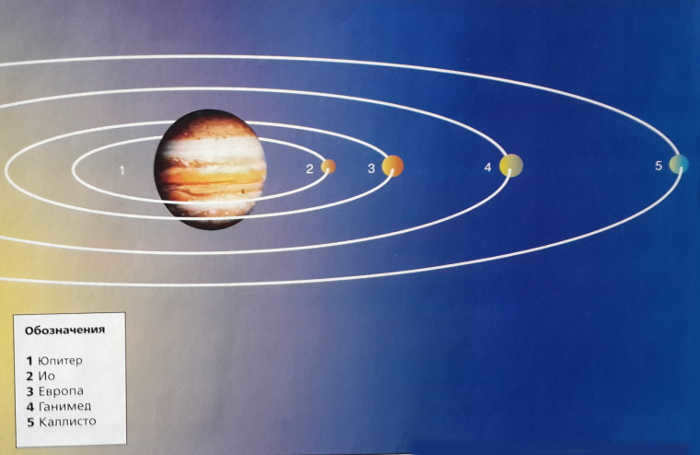
< p > Just like the planets in our solar system, the Galilean satellites’ size and composition vary depending on their distance from Jupiter. Io and Europa, which are the closest satellites, are approximately the same size as the Moon and likely have a similar composition. On the other hand, Ganymede and Callisto, although larger in size than Mercury, have a significantly lower mass. This leads scientists to believe that these two satellites are primarily made up of water and ice. < /p >
Io, which is the nearest of Jupiter’s Galilean satellites, orbits the planet at a distance of 421,600 km. It completes one full revolution around Jupiter every 1.8 days. Interestingly, Io completes two revolutions during the orbital period of Europa, another Galilean satellite, and Europa itself completes two revolutions during the orbital period of Ganymede. This means that Io is in a 1:2 resonance with Europa and a 1:4 resonance with Ganymede. Due to the gravitational fields of Europa and Ganymede, the radius and shape of Io’s orbit are constantly changing.
The volcanic activity on Io, which has volcanic craters covering more than 5% of its surface with diameters ranging from 10-50 km, is believed to be primarily caused by the gravitational field disturbances created by Europa and Ganymede. These disturbances have led to the formation of large volcanoes on Io, which are named after mythological figures associated with fire, such as Prometheus. The eruptions from these volcanoes release significant amounts of sulfur dioxide and potentially other gases, creating a thin atmosphere on Io. This abundance of sulfur in Io’s atmosphere is responsible for its distinctive orange color.
Io is the third largest moon of Jupiter’s Galilean satellites, measuring 3630 km in diameter and weighing approximately 8.94×10^22 kg. It is believed to have a core composed of liquid and solid sulfur and sulfur dioxide, surrounded by a mantle and crust.
Europa, Jupiter’s Smallest Satellite
Europa, the smallest satellite of Jupiter, has a diameter of 3,138 km and a mass of 4.8×10^22 kg. It orbits at a distance of 670,900 km from Jupiter and completes a full revolution in just 3.6 days. The surface of Europa is flat and icy, with a network of enormous cracks that can extend for thousands of kilometers and reach widths of up to 40 km. These cracks are believed to have formed due to gravitational disturbances caused by the movement of other satellites, similar to how Io’s volcanoes are created.
Astronomers speculate that Europa is made up of rocks similar to those found on Io, but with a layer of ice approximately 100 kilometers thick covering them.
V. Ganymede
Ganymede is the third satellite of Jupiter, known as one of the Galilean satellites. It has a diameter of 5,262 km and a mass of 1.48×10^23 kg. Ganymede orbits at a distance of 1,070,000 km from Jupiter and has an orbital period of 7.2 days.
The surface of Ganymede is fascinating, with numerous craters and formations that resemble islands. The Galileo Region is the largest feature on its surface, spanning about 4,000 km. These craters are believed to be remnants of asteroid impacts that occurred approximately 4.6 billion years ago.
Interestingly, Ganymede has a lower density compared to its neighboring satellites, Io and Europa, with a value of 1.94 g/cm^3. This suggests that Ganymede is composed mainly of an icy mantle, approximately 1,000 km thick, surrounding a small rocky core.
The most distant moon of Jupiter, Callisto, completes a full orbit around the planet in 16.7 days, covering a distance of 1,883,000 km. It is known for having the highest number of impact craters in the entire solar system. The most prominent crater, Valhalla, resembles water that has frozen after a large rock plunged into it. Given the size of the crater, approximately 600 km, it can be inferred that the object that collided with Callisto was of considerable size.

